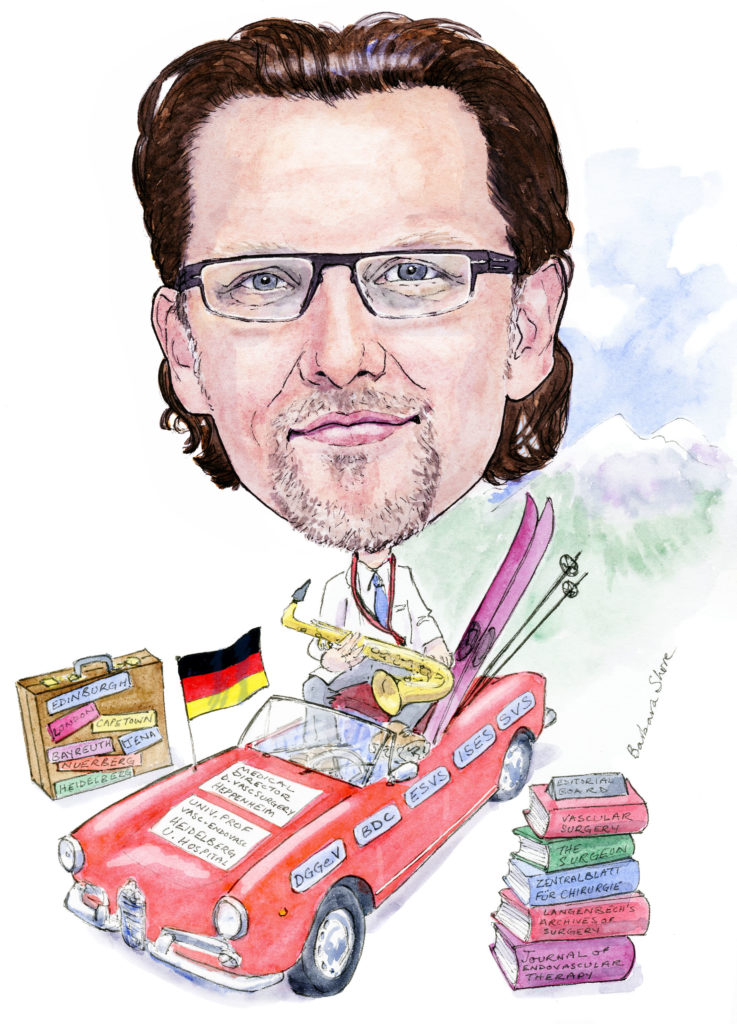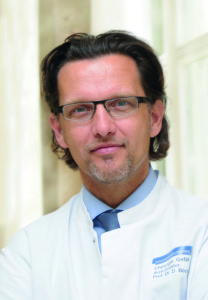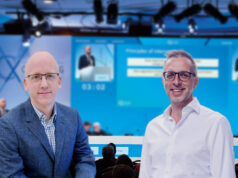
A budding pilot, Dittmar Böckler’s flight plan was altered by the onset of a sudden illness as a teenager. The experience introduced him to the world of medicine and awakened a desire to become a surgeon. He told Vascular News how his move to the vascular specialty was pure coincidence, but one that has since turned out to be a happy one.
Why did you decide you wanted a career in medicine, and why in particular did you choose to enter the vascular field?
I never wanted to do medicine until the age of 17 years old; to become a pilot was my dream! I started to build little remote-controlled airplanes at the age of 8, I took gliding lessons and I was registered for the PPL (private pilot license) in Phoenix, Arizona, by the age of 17.
Then, I fell seriously ill overnight and during that time, I discovered the wonders of medicine and especially surgery. From the first day of medical school, surgery was the new professional dream.
Working on liver transplants, which I did for two years, was fascinating for me. The move to vascular medicine was coincidental. As if often the case in life, “switches in life work sometimes perchance”—I do not regret this at all.
Who have been your most important career mentors and what wisdom did they impart?
Honestly, I did not have a mentor in my early career at all, unfortunately. It was a time, when, at least in Germany, chiefs and head of departments said: “Shut up and do what I tell you. If you do not like it, there 10 others waiting for your job.” To boost and promote young fellows was not part of the strategy in the 90s.
This was something that I wanted to change and do differently in case I one day became responsible for people. Luckily, these times are gone, and these personalities are retired or probably “in heaven”. Mentorship is very important: for the individual, for a team and for the evolution of the speciality you are in.
Of course I met people who influenced me and somewhat “smoothed” my way—Dieter Raithel, in Nuremberg, Germany, and Jens R Allenberg in Heidelberg, Germany, are two that come to mind.
Other visionary pioneers also inspired me, such as Barry Katzen, Michael Dake, Ted Diethrich, and Frank Veith, who I visited during a travel grant trip through the USA about 15 years ago. They are great people, and there are some more for sure, such as Takao Ohki, Wolf Stelter, to name just two.
What has been the biggest development(s) in vascular medicine during the course of your career?
The extension of endovascular therapy from iliac stenting and endovascular aneurysm repair (EVAR) to thoracoabdominal EVAR, fenestrated EVAR, branched EVAR but also TAVI and the optimisation of best medical treatment.
From the perspective of a vascular surgeon, it is also the adaption of all these techniques within our speciality. Many vascular surgeons are well-skilled in endovascular treatment and can provide brought vascular care to their patients.
The increase of evidence from randomised trials and especially from large, long-term post-market registries has also been very beneficial to decision-making processes and to our patients.
Last but not least, it is the new environment of hybrid operating rooms in which fusion imaging techniques optimise technical results and increase both patient and staff safety by reducing radiation, contrast media, etc.
When did you perform your first EVAR? Can you please describe the procedure and what you learnt from it?
I observed and assisted my first EVAR procedures in 1998 when Dieter Raithel and his team in Nuremberg used all commercially available devices on the market, including AneuRx and Ancure, among many others. At that time, they already had experience with more than 600 procedures. It took more than three years until I got the chance to perform my first EVAR in 2002. I used a Lifepath stent-graft (a balloon-expandable stent-graft from Edwards which has not been on the market for many years) with a C-arm and femoral cutdowns. What I learned and recognised at that time, as far as I remember, was that: treatment of aortic diseases is my baby, EVAR is the future, and I needed to be part of it. Working in a university institution, I would try to get involved actively into this specific field.

Can you please tell us also about the most challenging aortic aneurysm case you managed to treat with a total endovascular solution?
A young 34-year-old mother of two children comes to mind. She had open surgery for coarctation of the abdominal aorta at the age of 18. She developed proximal and distal anastomotic aneurysms of Dacron graft from the proximal descending to the infrarenal aorta involving a reimplanted single left kidney. We performed embolisation of the residual descending aortic lumen to avoid endoleak, implanted a tapered thoracic stent graft percutaneously and, four weeks later, staged a custom-made device for the abdominal segment preserving the renal artery using fusion navigation in very short landing zones. Avoiding re-thoracotomy and laparotomy, working percutaneously and discharging this young patient after three days is so persuasive that “endo”, even out of instructions for use and without knowing long-term results, is a huge benefit for many patients, both elderly and young.
What is the most interesting paper or presentation that you have seen recently (aside from your own research)?
Well, there have been plenty of interesting papers published in the last three years and it is difficult to rank them. I am biased for sure, but I am excited by two of them:
Global experience with an inner branched arch endograft by Stéphan Haulon et al from Lille, France, because it is signaling the next step to be taken;
DISSECT: a new mnemonic-based approach to the categorisation of aortic dissection by Michael Dake, Matt Thompson, and other DEFINE Investigators, because it is a practical and helpful approach to treating patients with acute dissections; a very demanding patient population.
I was very much impressed by the session led by Roger Greenhalgh this year at Charing Cross Symposium presenting the potential harm of radiation exposure to famous pioneers in vascular medicine.
The effect of radiation exposure to operators has become a major concern in the vascular community. What is your team in Heidelberg doing to address this hazard?
As mentioned earlier, this hazard has been the focus of my personal daily practice over the last year. We started to treat patients in a hybrid OR in 2009, and staff were afraid about the “new modern machines exposing anybody with more radiation”. First, to overcome those subjective emotions from staff, we collected data prospectively and published in the Journal of Vascular Surgery, together with Eric Verhoeven, on radiation exposure to eye lenses and operator hands during endovascular procedures in hybrid ORs. We equipped everybody with personal leads including glasses; we qualified each team member and started with continuous education (As Low As Reasonably Achievable—ALARA), and we introduced care body (low radiation) programmes and angioruns under fluoro (rather than digital subtraction) in the workflow. We realised that dose-area-product (DAP) is even more important than fluoroscopy time, and we benchmarked ourselves with other institutions Our last step was to employ Raysafe, an online radiation measurement tool. It is impressive how everybody now focuses on exposure reduction.
It is very important to reduce radiation, not per procedure but per case, ie. including pre- and post-X-ray exposure. This is the true goal and a quality parameter in endovascular therapy these days.
What is your experience with endovascular methods of treating the ascending aorta? How do you see this area developing in the future?
Endovascular therapy will definitely approach and conquer the ascending aorta and the totality of the arch. There is a big need for it, looking at the epidemiology of aortic ascending and arch pathologies, as well as morbidity and mortality and turndown rates for standard open repair. Look at TAVI; the same thing will happen with the aorta—it may not be a first choice treatment option at first, but like EVAR and TEVAR, it will be complimentary and non-competitive. In my mind, this kind of treatment and technology should be centralised in high-volume aortic centres, in which interdisciplinary infrastructure is provided. I will try together, with my team, to be one of those centres which can offer the endovascular treatment option as an alternative in the very near future.
Endovascular treatment of uncomplicated type B dissections is still a controversial topic. What is your protocol for treating uncomplicated dissections and how do you think the field can reach a consensus on this topic?
Despite the two randomised trials (INSTEAD and ADSORB) and despite DISSECT—the new mnemonic-based approach cited earlier—many answers are still missing. We need a new powered randomised trial while retrospectively analysing CT-based predictors of progression and negative outcomes for proper patient selection in so-called uncomplicated type B dissections. These six or seven predictors, eg. entry size, partial lumen thrombosis, etc, are published in single-centre series. Currently, each patient is taken to our ICU, receives a CT scan on days three, 10, and 14, undergoes close clinical and blood test surveillance, and if refractory hypertension, thoracic pain and/or multiple predictors are present, we treat them after day 14 in the subacute phase, if possible. This protocol is of course always under evolution.
Could you please tell us about one of your most memorable cases? What did this experience teach you?
Well, even while being optimistic, very often the most memorable cases are failures.
I remember nearly each patient who suffered from paraplegia after TEVAR, BEVAR or open surgery. For me, it is still unpredictable in daily practice, even knowing the risk factors and using preventive measures such as pressure-controlled cerebrospinal fluid drainage. This field needs further intensive research.
I am always surprised by how well elective surgical conversion patients perform—those treated with EVAR because they have been classified as being at high risk for open surgery. Risk stratification by scores does not seem to work yet. Furthermore, we need to be trained and skilled in open techniques; open surgery is still a valid and durable treatment option!
I remember well performing the first European EVAS (Nellix) procedure. This was very exciting because a new concept was evolving after decades of EVAR. We are still learning which patients benefit most, but it is necessary to move on and to push the envelope of the ongoing endovascular revolution.
What are some of the proudest moments in your career?
One most memorable moment in my professional life was to become Chair of the Department of Vascular and Endovascular Surgery at the University of Heidelberg. This was not my initial plan, but it was possible because of a strong belief and vision, due to a great team and many supporters backstage.
What advice would you give to young vascular surgeons starting out in their careers?
I like this advice from Mark Twain: “Keep away from people who try to belittle your ambitions. Small people always do that, but the really great make you feel that you, too, can become great.”
Further, I would advise young surgeons to get a mentor and coach—it helps to improve your learning curve and to avoid mistakes that do not necessarily need to be repeated.
To the young next generation starting their medical careers, I would tell them to go into vascular patient care. It is exciting, demanding, revolutionary and satisfying. Get your own vision and keep on track, but continuously reflect on your own actions. In medicine, it is all about your patient!
What three questions in vascular medicine still need to be answered?
- Which patients should not be treated?
- How can best treatment remain payable in times of financial restrictions?
- When do we (regardless of disciplines in vascular medicine) finally practise as “vascular and endovascular specialists” rather than fighting each other’s’ competence?
What are some of your hobbies and interests outside of medicine?
You can see in my caricature! I like skiing and hiking on the mountains; I enjoy cars from the 50s and 60s and also saxophone music.
Fact File
Professorships
2007 Associate Professor of Surgery, University of Heidelberg, Germany
2011 University Professor of Vascular and Endovascular Surgery, Chairman of Department, University of Heidelberg, Germany
Clinical training (selected)
1993–1994 Internship/House Officer at the Department of Vascular Surgery, Friedrich-Alexander University at Erlangen-Nürnberg, Germany
1994–1995 Resident/Registrar at the Department of General, Visceral & Trauma Surgery, University Hospital Heidelberg, Germany
1995–1998 Resident/Registrar at the Department of General and Visceral Surgery der Friedrich-Schiller University of Jena, Germany
1998 Resident/Registrar at the Department of Trauma and Reconstructive Surgery at the Clinical Center/Centre Bayreuth, Germany
1998–2002 Resident/Registrar at the Department of Vascular Surgery, at the Clinical Center/Centre Nuremberg-Sued, Germany
2002–2006 Attending Physician/Medical Consultant at the Department of Vascular Surgery, University Hospital Heidelberg, Germany
2006–2007 Chief Attending Physician /Senior Medical Consultant and Deputy Medical Director at the Department of Vascular Surgery, University Hospital Heidelberg, Germany
2007–present Medical Director at the Department of Vascular Surgery and Endovascular Surgery, University Hospital Heidelberg, Germany
2011–present Medical Director and Chairman of the Department of Vascular and Endovascular Surgery, University Hospital Heidelberg, Germany
University education
1986–1993 Human Medicine, Friedrich-Alexander University of Erlangen-Nuremberg, Germany
2007–2009 Master of Health Business Administration, Friedrich-Alexander University of Erlangen-Nuremberg, Germany













